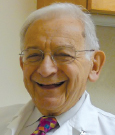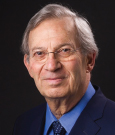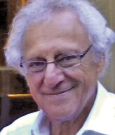Far and away the best prize that life has to offer is the chance to work hard at work worth doing.
—Theodore Roosevelt
Longevity, in and of itself, is not an accomplishment. Luck and good genes are just human lottery tickets. Most people fortunate enough to live long lives have a productive sweet spot in their chronology, and as they grow older they cherish the memory of that distant part of their lives. Then there are the rare people who tend to suspend time, never letting nostalgia get in the way of the important work ahead. One such person is oncology luminary James F. Holland, MD, Distinguished Professor of Neoplastic Diseases in the Department of Medicine at the Icahn School of Medicine at Mount Sinai in New York. Dr. Holland celebrated his 90th birthday on May 16, 2015.
“Dr. Holland has always been a true leader and an inspirational figure, willing to tackle the toughest problems. On his 90th birthday, he is still challenging the conventional wisdom with his continuing research,” said oncology pioneer Emil J. Freireich, MD, of his colleague.
A Career Path Is Set
Dr. Holland was born on May 25, 1925, in Morristown, New Jersey, where he grew up as the second youngest of four boys. He decided early on to become a doctor. After graduating from Columbia University College of Physicians and Surgeons and completing his residency, Dr. Holland served as a captain in the U.S. Army Medical Corps during the Korean War.
“I was set to begin my medical staff rotations,” Dr. Holland explained, “but I had to stay in the Army longer than expected because President Truman extended everyone’s tour of duty. I wrote the Chair of Medicine at Columbia Presbyterian Hospital and said I wouldn’t be back by July 1, which is when the staff rotations began. He wrote back to me saying that he couldn’t save a place for me because he needed the house to take care of patients. However, they’d just opened a new cancer hospital called Francis Delafield, run by Columbia and paid for by the City of New York, and the Chair assured me he’d place me there after somebody dropped out for tuberculosis or psychiatric reasons.”
Dr. Holland and many of his other celebrated friends and colleagues began their groundbreaking work before oncology had been established as a formal medical discipline; in those days, choosing oncology as a profession was for a select few visionaries. Oftentimes serendipity plays a role in the weighty decision of one’s career choice; in Dr. Holland’s case, that serendipity came in the form of a patient by the name of Jennifer.
“I left the Army at the end of September. There was no formal fellowship in medical oncology at the time, but I worked under the aegis and supervision of Alfred Gellhorn, MD, who was my mentor at the Francis Delafield Hospital at Columbia University in New York. While there, I had a 4-year-old patient named Jennifer who had acute leukemia. I treated her with aminopterin, and she went into remission. It was fantastic to see this drug work. When the Chair of Medicine from Columbia Presbyterian called me to say that a place had opened up for me, I thanked him and said I’d decided to stay at the cancer hospital. That’s when I really decided on oncology,” said Dr. Holland.
A New Era of Chemotherapy
In 1953, Dr. Holland joined the National Cancer Institute (NCI). Up until then, the NCI had locations across the country, but when the Institute was centralized on the National Institutes of Health (NIH) campus, it generated an intense atmosphere of collective scientific research. “I was a medical officer and perhaps the most senior clinician. My immediate superior was Leonard Fenninger, who I think was Chief of the Medical Service, and at the time G. Burroughs Mider was the Acting Clinical Director. I ran research activity primarily in acute leukemia at the time, and some junior colleagues who had just finished their residency joined me,” explained Dr. Holland.
He continued, “Dr. Mider introduced me to Lloyd Law, PhD, who had shown that in leukemic mice, a combination of drugs given at the same time was better than when given in sequence. Dr. Law and I became wonderful friends, and I learned a lot about science from him. So I continued research in combination therapy, and when it became clear that mercaptopurine and methotrexate were two clinical drugs that were active in childhood leukemia, I put together a protocol with Dr. Law’s approbation.”
William Newton, MD, of the Children’s Hospital in Columbus, Ohio, and Dr. Holland were the first researchers to give those two drugs in combination. “The strategy was based on the concept that about one-third of patients responded to methotrexate and about one-third responded to mercaptopurine, so theoretically, one in nine might be sensitive to both and conceivably achieve a cure. It was the beginning of a new era in chemotherapy,” said Dr. Holland.
Reflecting on his friend and colleague’s immense contribution to oncology, Vincent T. DeVita, MD, noted, “Jim Holland is one of the founding fathers of cancer chemotherapy. Without his ebullient support and his leadership of the cooperative group Acute Leukemia Group B, the work on childhood leukemia might have gone unnoticed. His work confirmed the curative potential of combination chemotherapy. He is also one of a stellar group of trainees of the great Alfred Gelhorn, Director of the Delafield Cancer Center at Columbia, which included John Ultmann, Paul Marks, Franco Muggia, Helen Ranney, Elliott Osserman, George Hyman, and others.”
Dr. Holland served at the NCI from July 1953 to November 1954. Dr. Freireich, another founding father of combination chemotherapy, reflected on his colleague’s legacy. “Dr. Holland, who preceded me at the NCI, had attracted several children with acute leukemia and had begun treating them with the chemotherapeutic agents then available. Over the next 10 years I developed combination chemotherapy regimens that resulted in a cure for a fraction of children, and it was the first systemic metastatic cancer to be cured. So the high point of my career was attributed to Dr. Holland’s foresight in leaving the children under my care.”
Personal and Professional Fulfillment at Roswell Park
After receiving a job offer at Roswell Park Cancer Institute, Dr. Holland journeyed north from Bethesda, Maryland, to Buffalo, New York. His tenure at Roswell Park would be a rich experience for both his research career and his personal life. There, a chance visit by a young doctor would end in marriage, forging one of the oncology community’s most accomplished and cherished husband-and-wife teams: James and Jimmie Holland.
“Jim was Chief of Medicine at Roswell Park at the time. I was in residency in St. Louis and went to Buffalo to visit a dear woman colleague who was a surgical fellow at Roswell. It was a lucky chance that we met. Our many years together and six children speak to just how lucky we both were to find each other,” said Jimmie Holland, MD, Wayne E. Chapman Chair in Psychiatric Oncology at Memorial Sloan Kettering Cancer Center.
Oncology trailblazer Pierre R. Band, MD, spoke of his time with Dr. Holland at Roswell Park. “I joined the Department of Medicine headed by James F. Holland, MD, at Roswell Park Memorial Institute in Buffalo, New York. I consider Dr. Holland the mentor who taught me cancer medicine and who introduced me to two of the main cooperative oncology groups: the Acute Leukemia Group B (subsequently Cancer and Leukemia Group B) and the Eastern Cooperative Oncology Group (ECOG). During those years, I benefited from Dr. Holland’s pioneering work at what was the forefront of cancer medicine.”
While Dr. Holland was at Roswell Park, C. Gordon Zubrod, MD, who was Head of NCI’s Division of Cancer Treatment, recruited him and Emil “Tom” Frei III, MD, establishing a continuing collaboration to test anticancer drugs. “We published the first collaborative oncology paper in the United States, which appeared in Blood. Following that, the Cancer Chemotherapy National Service Center (CCNSC) was established under the impetus of Mary Lasker, led by Dr. Kenneth Endicott, who later became Director of the NCI. It set up a network of cooperative clinical trial groups that evolved across the country under the auspices of the NCI,” said Dr. Holland.
Going Behind the Iron Curtain
Asked about winning the Lasker Award, Dr. Holland replied, “First off, I am a strong believer that Mary Lasker was this country’s most important person in cancer research. She felt that cancer awareness needed a boost, so in 1972, the Lasker Award was given to clinicians who made progress in treating cancer. About 18 of us won the Lasker; Tom Frei won for Hodgkin lymphoma, and I won for acute leukemia. It was a $2,000 prize, which was big-time money then.”
However, an unexpected mission would take Dr. Holland and his family behind the Iron Curtain, leaving his seat at the Lasker Award ceremony empty. “During the Cold War, Nixon and Brezhnev tried to put aside the notion of dropping atomic bombs on each other and agreed that finding a cure for cancer would be mutually beneficial. So Brezhnev would send a scientist with his family to the United States, and we, in turn, would send a counterpart family to Russia.
Dr. Zubrod enlisted me and others to find a candidate, but no one wanted to go. I was leaving Roswell Park at the time, and after the third call from Dr. Zubrod, I asked Jimmie, ‘how about us?’ She said okay, and off we went with our six kids. I missed the Lasker ceremony, but we had an extraordinary experience for 7 months in the Soviet Union. I lectured all over the Soviet Union and was welcomed, even though I came from a contrary political system. I’ve never had better audiences than I had in the Soviet Union—standing room only. As for the family, the three boys had to sleep in one room, and the three girls in another, and it added to the community and bonding between them,” said Dr. Holland.
ASCO Presidency
Dr. Holland, who served as ASCO President from 1976 to 1978, admits that he was an early skeptic of ASCO’s true value in the field of oncology. “I did not think it would get to its present level of extreme value. It started small, like everything. But we have to pay attention to the concept that a small group of dedicated people is the only thing in the world that ever has changed things, and ASCO has changed things,” he said.
Asked to amplify his thoughts on the field that he has dedicated his life’s work to and to the Society that he has been an integral part of, Dr. Holland responded, “Oncologists are occupied with an unusual kind of medicine, and, as a result, we are exposed to enormous personal stress and strain, because patients we care for are profoundly sick with potentially fatal diseases. As a group, we deal with the possible mortality of those for whom we are responsible, far more than physicians of most other specialties. So, an important part of being able to sustain oneself in oncology is to have the camaraderie of fellow oncologists, kindred souls who have the same experiences, who are facing the same challenges and who understand. ASCO has served wonderfully for me and for many others to maintain the recognition that we are all in this long and difficult chore together.”
Still Pushing the Boundaries
Finding the etiology of disease is the pathway to prevention and possibly cures. Such is the motivation of Dr. Holland’s cutting-edge research. “I see patients on certain days of the week and interact with my laboratory colleagues. We are deeply engrossed in the research that I’ve pursued for 20 years, exploring a virus in human breast cancer that is a ‘kissing cousin’ of the mouse mammary tumor virus, the causative agent for breast cancer in mice. Forty percent of American women who present with breast cancer have this virus in their tumor, but not in the normal tissue of the same breast, which thus excludes genetic inheritance. It is acquired. We are working hard to fulfill the criteria that will prove the virus is indeed the cause of these breast cancers. It keeps me busy and out of trouble,” said Dr. Holland.
When people open their eyes in the morning, they are greeted with a new day, full of the vagaries and insecurities that come with human life. We are obliged to do something with the day ahead. Dr. Holland goes to work at the hospital and the lab. It’s important that he does, and for that alone, he should serve as an inspiration for every young doctor dreaming of entering the noble field of oncology. ■







